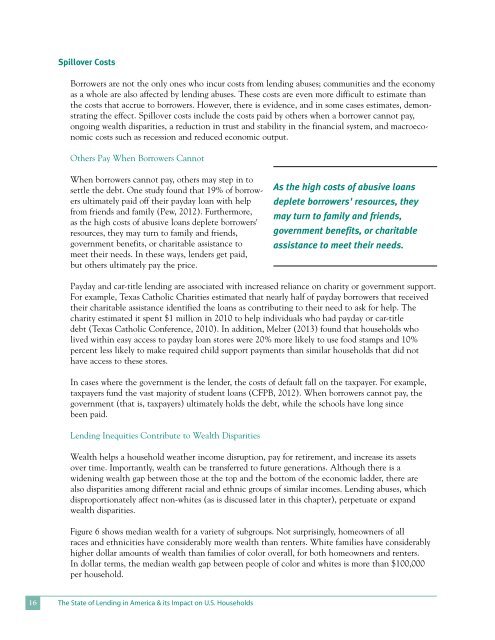You also want an ePaper? Increase the reach of your titles
YUMPU automatically turns print PDFs into web optimized ePapers that Google loves.
Spillover <strong>Costs</strong><br />
Borrowers are not the only ones who incur costs from lending abuses; communities and the economy<br />
as a whole are also affected by lending abuses. <strong>The</strong>se costs are even more difficult to estimate than<br />
the costs that accrue to borrowers. However, there is evidence, and in some cases estimates, demonstrating<br />
the effect. Spillover costs include the costs paid by others when a borrower cannot pay,<br />
ongoing wealth disparities, a reduction in trust and stability in the financial system, and macroeconomic<br />
costs such as recession and reduced economic output.<br />
Others Pay When Borrowers Cannot<br />
When borrowers cannot pay, others may step in to<br />
settle the debt. One study found that 19% <strong>of</strong> borrowers<br />
ultimately paid <strong>of</strong>f their payday loan with help<br />
from friends and family (Pew, 2012). Furthermore,<br />
as the high costs <strong>of</strong> abusive loans deplete borrowers'<br />
resources, they may turn to family and friends,<br />
government benefits, or charitable assistance to<br />
meet their needs. In these ways, lenders get paid,<br />
but others ultimately pay the price.<br />
As the high costs <strong>of</strong> abusive loans<br />
deplete borrowers' resources, they<br />
may turn to family and friends,<br />
government benefits, or charitable<br />
assistance to meet their needs.<br />
Payday and car-title lending are associated with increased reliance on charity or government support.<br />
For example, Texas Catholic Charities estimated that nearly half <strong>of</strong> payday borrowers that received<br />
their charitable assistance identified the loans as contributing to their need to ask for help. <strong>The</strong><br />
charity estimated it spent $1 million in 2010 to help individuals who had payday or car-title<br />
debt (Texas Catholic Conference, 2010). In addition, Melzer (2013) found that households who<br />
lived within easy access to payday loan stores were 20% more likely to use food stamps and 10%<br />
percent less likely to make required child support payments than similar households that did not<br />
have access to these stores.<br />
In cases where the government is the lender, the costs <strong>of</strong> default fall on the taxpayer. For example,<br />
taxpayers fund the vast majority <strong>of</strong> student loans (CFPB, 2012). When borrowers cannot pay, the<br />
government (that is, taxpayers) ultimately holds the debt, while the schools have long since<br />
been paid.<br />
Lending Inequities Contribute to Wealth Disparities<br />
Wealth helps a household weather income disruption, pay for retirement, and increase its assets<br />
over time. Importantly, wealth can be transferred to future generations. Although there is a<br />
widening wealth gap between those at the top and the bottom <strong>of</strong> the economic ladder, there are<br />
also disparities among different racial and ethnic groups <strong>of</strong> similar incomes. Lending abuses, which<br />
disproportionately affect non-whites (as is discussed later in this chapter), perpetuate or expand<br />
wealth disparities.<br />
Figure 6 shows median wealth for a variety <strong>of</strong> subgroups. Not surprisingly, homeowners <strong>of</strong> all<br />
races and ethnicities have considerably more wealth than renters. White families have considerably<br />
higher dollar amounts <strong>of</strong> wealth than families <strong>of</strong> color overall, for both homeowners and renters.<br />
In dollar terms, the median wealth gap between people <strong>of</strong> color and whites is more than $100,000<br />
per household.<br />
16<br />
<strong>The</strong> State <strong>of</strong> Lending in America & its Impact on U.S. Households


